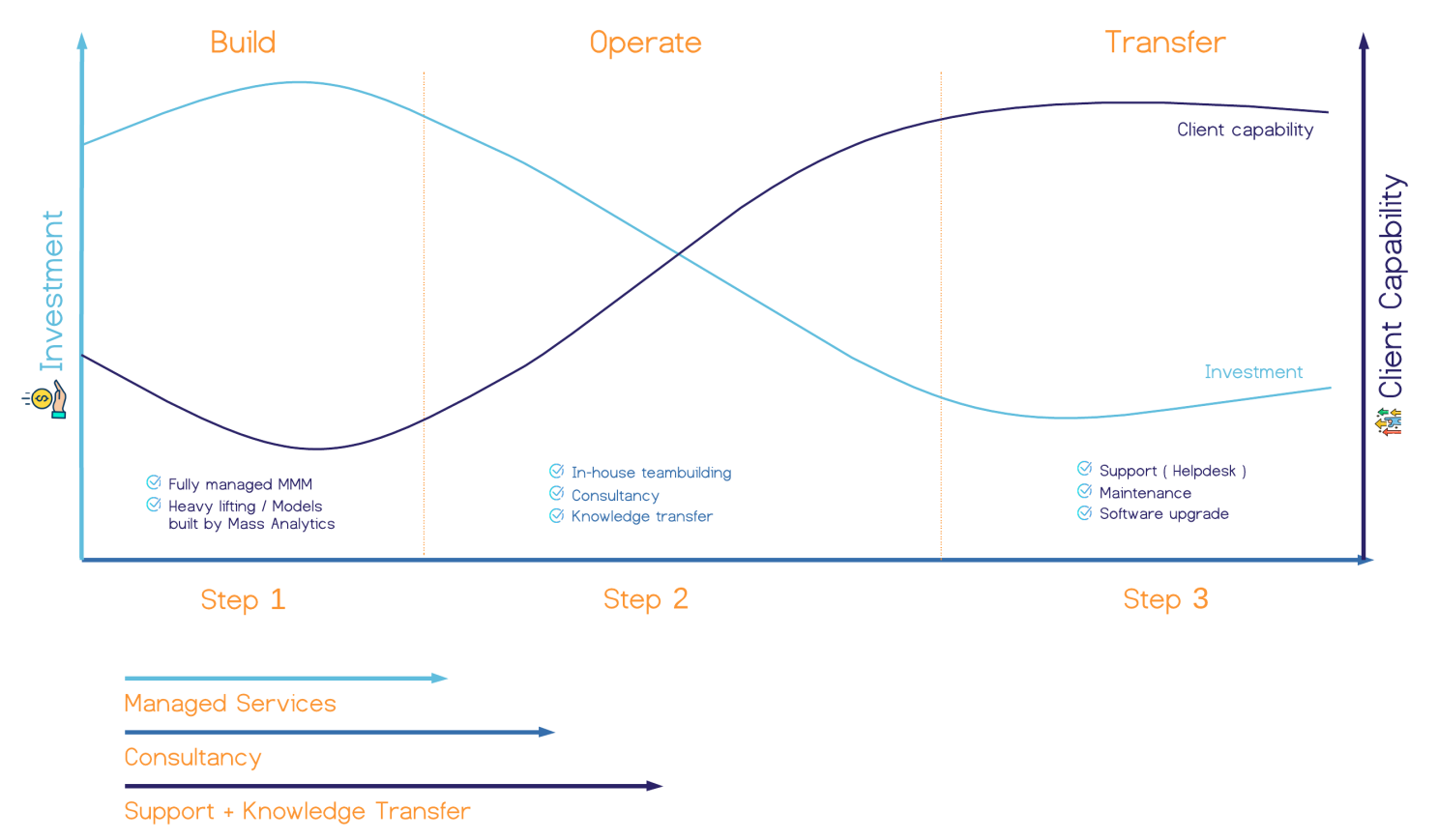What You Need to Know about MMM In-housing
In an environment characterized by a proliferating media landscape and strict privacy regulations, in-housing MMM has become a strategic move for any business regardless of its size. By in-housing, the business ensures full control over their data, their process, and the results and insights of their projects. They also guarantee the scalability and cost-efficiency of their models. In Bannerflow 2021 report, 63% of respondents stated that their ROI has seen a positive change since in-housing MMM. But, despite these tempting benefits, in-housing remains an investment that requires specific resources to be deployed and best practices to be applied. In this article, we cover some the key elements that ensure the success of in-housing MMM.
How best to in-house MMM:
An analytics team is a starting point but not enough
Go step by step
Choose the right partner
a. An analytics team is a starting point but not enough
Some companies have their own analytics team to whom they would prefer to assign their MMM projects. Though this is a reasonable choice, it should only be the beginning of a process whereby the team goes through an extensive training to acquire the right skills that allow them to consider any model from the mathematical as well as the business perspective, and to understand what transformations need to be applied to the data to model consumer response and get the right measures. Only then can the analytics team work their way backward to create a model that tackles the business question appropriately. This also entails that there should be exposure to the business, in order to have a better grasp of the goals they are supposed to achieve. Eventually, they will be able translate the technical process into an output that speaks to the business stakeholders. In that, results and insight dissemination should not be about how sophisticated the model is and what went into creating it, but rather about how it addresses the business question and helps the business make the right decisions. This balance between the mathematics behind a model, and the business story behind the variables, is the goal that a business should aspire to achieve when starting their process of in-housing MMM.
b. Go step by step
If Measurement is in your strategic roadmap, but you are hesitant for lack of experience or capabilities that an external agency might have, you can adopt the “Build, Operate, and Transfer” process. The latter starts with finding a Marketing Mix Modeling partner that will not only help you set up your MMM project but transfer knowledge to your internal teams about how to update the model. That eventually guarantees the complete independence of the internal team. The “Build, Operate, Transfer” process could start with complete dependence on the partner, as the graph below illustrates, but it is crucial to establish where you want to take Measurement in your company, and that your independence is the ultimate goal of the process.

👉 How long does the BOT process take?
This is directly related to how strategic in-housing MMM is for the client; how much time they are willing to dedicate and whether they create a team that is fully devoted to the project, for knowledge transfer to be a smooth process; the most important element in this is that this team be given the time to learn, ingest, and apply.
The role of the partner in BOT is crucial especially in the beginning; their experience allows deciding what types of variables and metrics should be collected, and set up the optimal project architecture by recommending the best structure that addresses both primary and secondary business questions. The partner’s experience comes in handy again when navigating the different steps of the CRISP-DM methodology (Cross Industry Standard Process for Data Mining) which is “a process model that serves as the base for a data science project delivery. It has six sequential phases:”
1. Business Understanding
2. Data Understanding
3. Data Preparation
4. Modeling
5. Evaluation
6. Deployment
👉 CRISP-DM is the process followed in any MMM project.
The partner’s job here is to take the client by the hand through all the steps until they can perfectly execute every step of CRISP-DM. This will have an impact on how long the process takes. So, it is of absolute importance to choose a partner wisely. But what makes a good MMM partner?
c. Choose the right partner
The key here is to choose a partner who is genuinely willing to share the secret sauce. This could be summed up in 5 points:
- Transparency: This is key. If the partner has transparency, as well as education, in their DNA, the journey to in-housing MMM will have a solid foundation. A partner who is not transparent about their processes will not guarantee the eventual independence of their client.
- Objectivity: Your partner should sit at an equal distance from all the performance drivers and provide insight and recommendations based on an objective analysis derived from the modeling results.
- A Thorough understanding of the measurement industry: Your partner should have a knowledge data base, benchmarks, and thorough experience in MMM to be able to provide clear guidelines in relation to how each variable needs to be transformed, processed and ingested in the models.
- Advanced Technology: A state-of-the-art, intuitive MMM software should either be provided or recommended by the partner to automate the workflow, ensure swift delivery of the results and guarantee scalability.
Conclusion:
Deploying MMM is becoming a need as it has become evident that cookies are going extinct; the question now is whether a business should in-house MMM. If they opt for in-housing, they need to ensure that they have a team capable of creating models that are robust from the mathematical and the business perspective. In the transition to successful in-housing, we recommend choosing a transparent and objective partner with enough experience and advanced technology to support the internal team through the process of mastering the technical and the business aspects of an MMM project.








